Counselling Theories Case Study: Psychoanalytic Approach and Stages
VerifiedAdded on 2019/09/23
|10
|2847
|404
Case Study
AI Summary
This case study delves into the application of psychoanalytic therapy, exploring its theoretical underpinnings rooted in Sigmund Freud's work. The study examines the therapy's stages, including the opening phase, development of transference, working through transference, and resolution of transference, highlighting the significance of the unconscious mind and early childhood experiences. It discusses contemporary psychoanalytic strategies such as unique episodes of self-change, introspection, and the use of play. The case study also addresses the limitations of this approach, including its time-consuming nature and potential cost, while emphasizing the importance of free association and the therapist-client relationship. The analysis underscores the dynamic nature of psychoanalytic therapy and its adaptability when combined with other therapeutic approaches.

Counselling theories
Case study
Name
Submitted to
Date
Case study
Name
Submitted to
Date
Paraphrase This Document
Need a fresh take? Get an instant paraphrase of this document with our AI Paraphraser
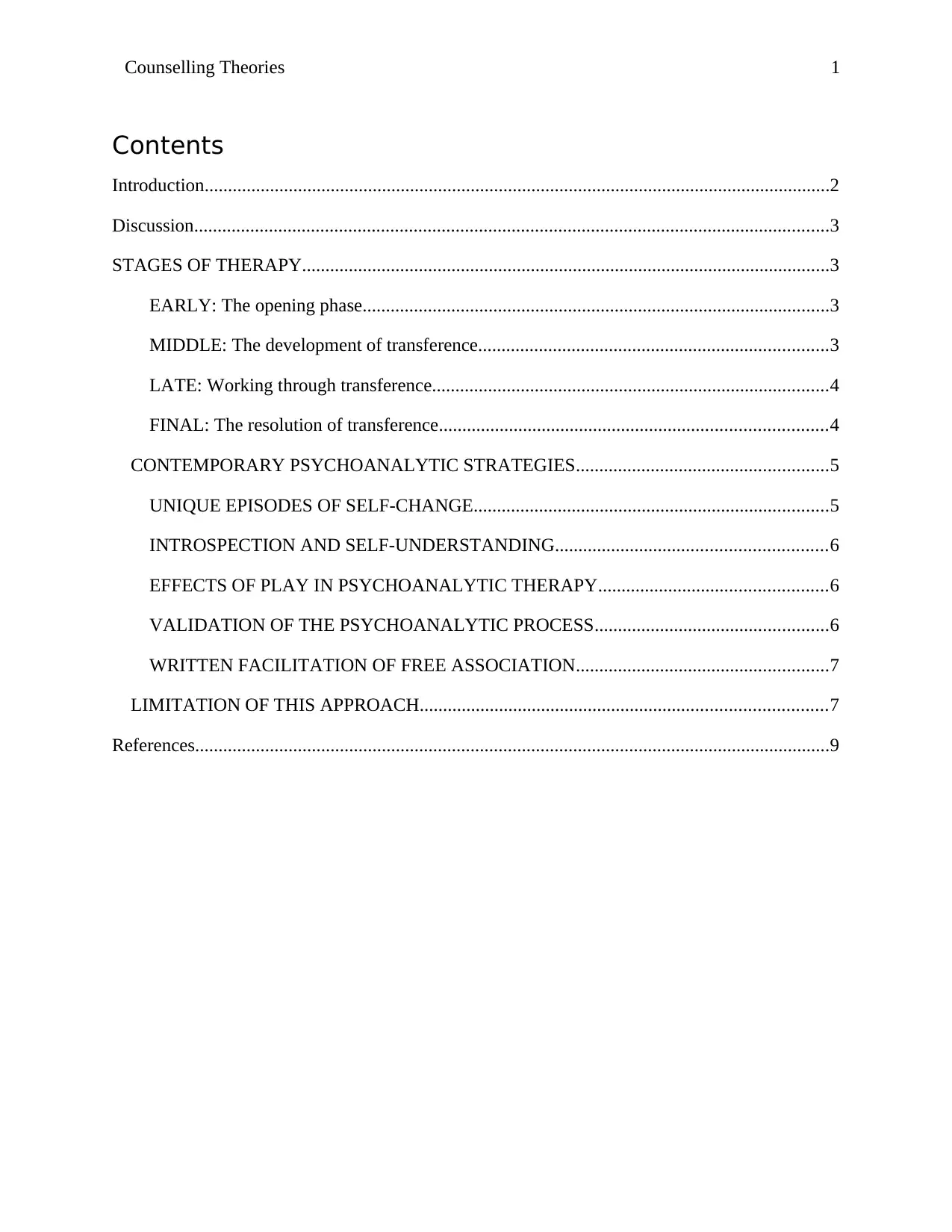
Counselling Theories 1
Contents
Introduction......................................................................................................................................2
Discussion........................................................................................................................................3
STAGES OF THERAPY.................................................................................................................3
EARLY: The opening phase....................................................................................................3
MIDDLE: The development of transference...........................................................................3
LATE: Working through transference.....................................................................................4
FINAL: The resolution of transference...................................................................................4
CONTEMPORARY PSYCHOANALYTIC STRATEGIES......................................................5
UNIQUE EPISODES OF SELF-CHANGE............................................................................5
INTROSPECTION AND SELF-UNDERSTANDING..........................................................6
EFFECTS OF PLAY IN PSYCHOANALYTIC THERAPY.................................................6
VALIDATION OF THE PSYCHOANALYTIC PROCESS..................................................6
WRITTEN FACILITATION OF FREE ASSOCIATION......................................................7
LIMITATION OF THIS APPROACH.......................................................................................7
References........................................................................................................................................9
Contents
Introduction......................................................................................................................................2
Discussion........................................................................................................................................3
STAGES OF THERAPY.................................................................................................................3
EARLY: The opening phase....................................................................................................3
MIDDLE: The development of transference...........................................................................3
LATE: Working through transference.....................................................................................4
FINAL: The resolution of transference...................................................................................4
CONTEMPORARY PSYCHOANALYTIC STRATEGIES......................................................5
UNIQUE EPISODES OF SELF-CHANGE............................................................................5
INTROSPECTION AND SELF-UNDERSTANDING..........................................................6
EFFECTS OF PLAY IN PSYCHOANALYTIC THERAPY.................................................6
VALIDATION OF THE PSYCHOANALYTIC PROCESS..................................................6
WRITTEN FACILITATION OF FREE ASSOCIATION......................................................7
LIMITATION OF THIS APPROACH.......................................................................................7
References........................................................................................................................................9
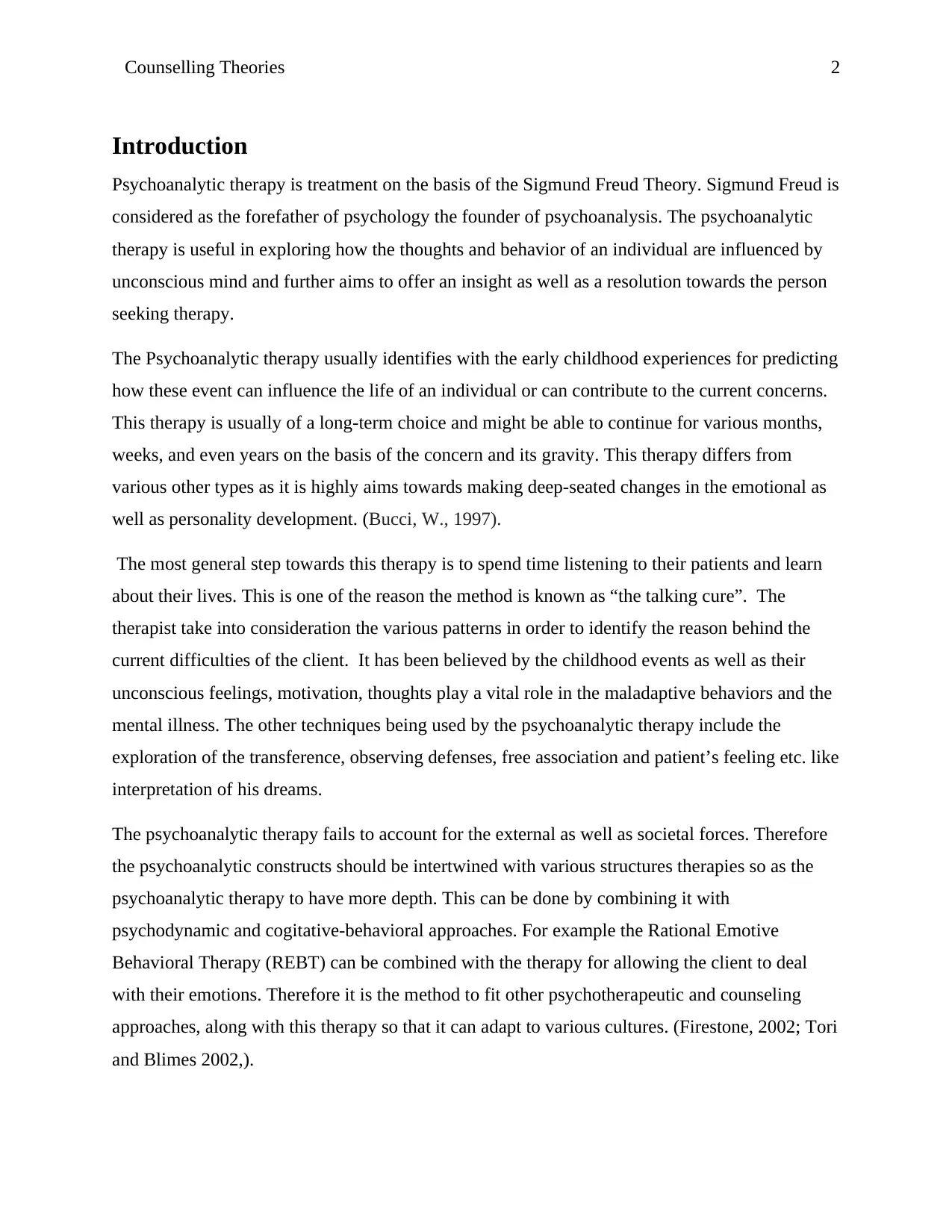
Counselling Theories 2
Introduction
Psychoanalytic therapy is treatment on the basis of the Sigmund Freud Theory. Sigmund Freud is
considered as the forefather of psychology the founder of psychoanalysis. The psychoanalytic
therapy is useful in exploring how the thoughts and behavior of an individual are influenced by
unconscious mind and further aims to offer an insight as well as a resolution towards the person
seeking therapy.
The Psychoanalytic therapy usually identifies with the early childhood experiences for predicting
how these event can influence the life of an individual or can contribute to the current concerns.
This therapy is usually of a long-term choice and might be able to continue for various months,
weeks, and even years on the basis of the concern and its gravity. This therapy differs from
various other types as it is highly aims towards making deep-seated changes in the emotional as
well as personality development. (Bucci, W., 1997).
The most general step towards this therapy is to spend time listening to their patients and learn
about their lives. This is one of the reason the method is known as “the talking cure”. The
therapist take into consideration the various patterns in order to identify the reason behind the
current difficulties of the client. It has been believed by the childhood events as well as their
unconscious feelings, motivation, thoughts play a vital role in the maladaptive behaviors and the
mental illness. The other techniques being used by the psychoanalytic therapy include the
exploration of the transference, observing defenses, free association and patient’s feeling etc. like
interpretation of his dreams.
The psychoanalytic therapy fails to account for the external as well as societal forces. Therefore
the psychoanalytic constructs should be intertwined with various structures therapies so as the
psychoanalytic therapy to have more depth. This can be done by combining it with
psychodynamic and cogitative-behavioral approaches. For example the Rational Emotive
Behavioral Therapy (REBT) can be combined with the therapy for allowing the client to deal
with their emotions. Therefore it is the method to fit other psychotherapeutic and counseling
approaches, along with this therapy so that it can adapt to various cultures. (Firestone, 2002; Tori
and Blimes 2002,).
Introduction
Psychoanalytic therapy is treatment on the basis of the Sigmund Freud Theory. Sigmund Freud is
considered as the forefather of psychology the founder of psychoanalysis. The psychoanalytic
therapy is useful in exploring how the thoughts and behavior of an individual are influenced by
unconscious mind and further aims to offer an insight as well as a resolution towards the person
seeking therapy.
The Psychoanalytic therapy usually identifies with the early childhood experiences for predicting
how these event can influence the life of an individual or can contribute to the current concerns.
This therapy is usually of a long-term choice and might be able to continue for various months,
weeks, and even years on the basis of the concern and its gravity. This therapy differs from
various other types as it is highly aims towards making deep-seated changes in the emotional as
well as personality development. (Bucci, W., 1997).
The most general step towards this therapy is to spend time listening to their patients and learn
about their lives. This is one of the reason the method is known as “the talking cure”. The
therapist take into consideration the various patterns in order to identify the reason behind the
current difficulties of the client. It has been believed by the childhood events as well as their
unconscious feelings, motivation, thoughts play a vital role in the maladaptive behaviors and the
mental illness. The other techniques being used by the psychoanalytic therapy include the
exploration of the transference, observing defenses, free association and patient’s feeling etc. like
interpretation of his dreams.
The psychoanalytic therapy fails to account for the external as well as societal forces. Therefore
the psychoanalytic constructs should be intertwined with various structures therapies so as the
psychoanalytic therapy to have more depth. This can be done by combining it with
psychodynamic and cogitative-behavioral approaches. For example the Rational Emotive
Behavioral Therapy (REBT) can be combined with the therapy for allowing the client to deal
with their emotions. Therefore it is the method to fit other psychotherapeutic and counseling
approaches, along with this therapy so that it can adapt to various cultures. (Firestone, 2002; Tori
and Blimes 2002,).
⊘ This is a preview!⊘
Do you want full access?
Subscribe today to unlock all pages.

Trusted by 1+ million students worldwide
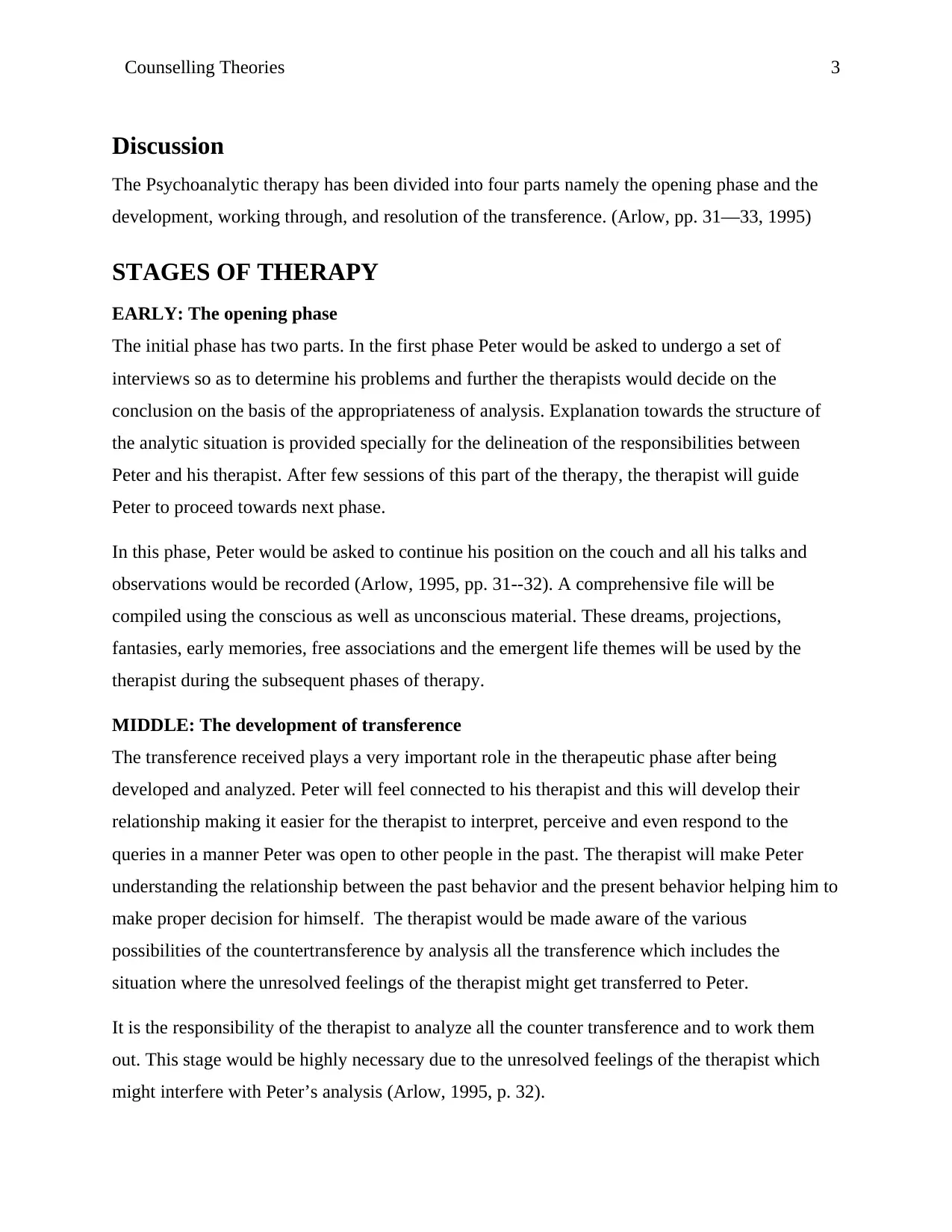
Counselling Theories 3
Discussion
The Psychoanalytic therapy has been divided into four parts namely the opening phase and the
development, working through, and resolution of the transference. (Arlow, pp. 31—33, 1995)
STAGES OF THERAPY
EARLY: The opening phase
The initial phase has two parts. In the first phase Peter would be asked to undergo a set of
interviews so as to determine his problems and further the therapists would decide on the
conclusion on the basis of the appropriateness of analysis. Explanation towards the structure of
the analytic situation is provided specially for the delineation of the responsibilities between
Peter and his therapist. After few sessions of this part of the therapy, the therapist will guide
Peter to proceed towards next phase.
In this phase, Peter would be asked to continue his position on the couch and all his talks and
observations would be recorded (Arlow, 1995, pp. 31--32). A comprehensive file will be
compiled using the conscious as well as unconscious material. These dreams, projections,
fantasies, early memories, free associations and the emergent life themes will be used by the
therapist during the subsequent phases of therapy.
MIDDLE: The development of transference
The transference received plays a very important role in the therapeutic phase after being
developed and analyzed. Peter will feel connected to his therapist and this will develop their
relationship making it easier for the therapist to interpret, perceive and even respond to the
queries in a manner Peter was open to other people in the past. The therapist will make Peter
understanding the relationship between the past behavior and the present behavior helping him to
make proper decision for himself. The therapist would be made aware of the various
possibilities of the countertransference by analysis all the transference which includes the
situation where the unresolved feelings of the therapist might get transferred to Peter.
It is the responsibility of the therapist to analyze all the counter transference and to work them
out. This stage would be highly necessary due to the unresolved feelings of the therapist which
might interfere with Peter’s analysis (Arlow, 1995, p. 32).
Discussion
The Psychoanalytic therapy has been divided into four parts namely the opening phase and the
development, working through, and resolution of the transference. (Arlow, pp. 31—33, 1995)
STAGES OF THERAPY
EARLY: The opening phase
The initial phase has two parts. In the first phase Peter would be asked to undergo a set of
interviews so as to determine his problems and further the therapists would decide on the
conclusion on the basis of the appropriateness of analysis. Explanation towards the structure of
the analytic situation is provided specially for the delineation of the responsibilities between
Peter and his therapist. After few sessions of this part of the therapy, the therapist will guide
Peter to proceed towards next phase.
In this phase, Peter would be asked to continue his position on the couch and all his talks and
observations would be recorded (Arlow, 1995, pp. 31--32). A comprehensive file will be
compiled using the conscious as well as unconscious material. These dreams, projections,
fantasies, early memories, free associations and the emergent life themes will be used by the
therapist during the subsequent phases of therapy.
MIDDLE: The development of transference
The transference received plays a very important role in the therapeutic phase after being
developed and analyzed. Peter will feel connected to his therapist and this will develop their
relationship making it easier for the therapist to interpret, perceive and even respond to the
queries in a manner Peter was open to other people in the past. The therapist will make Peter
understanding the relationship between the past behavior and the present behavior helping him to
make proper decision for himself. The therapist would be made aware of the various
possibilities of the countertransference by analysis all the transference which includes the
situation where the unresolved feelings of the therapist might get transferred to Peter.
It is the responsibility of the therapist to analyze all the counter transference and to work them
out. This stage would be highly necessary due to the unresolved feelings of the therapist which
might interfere with Peter’s analysis (Arlow, 1995, p. 32).
Paraphrase This Document
Need a fresh take? Get an instant paraphrase of this document with our AI Paraphraser
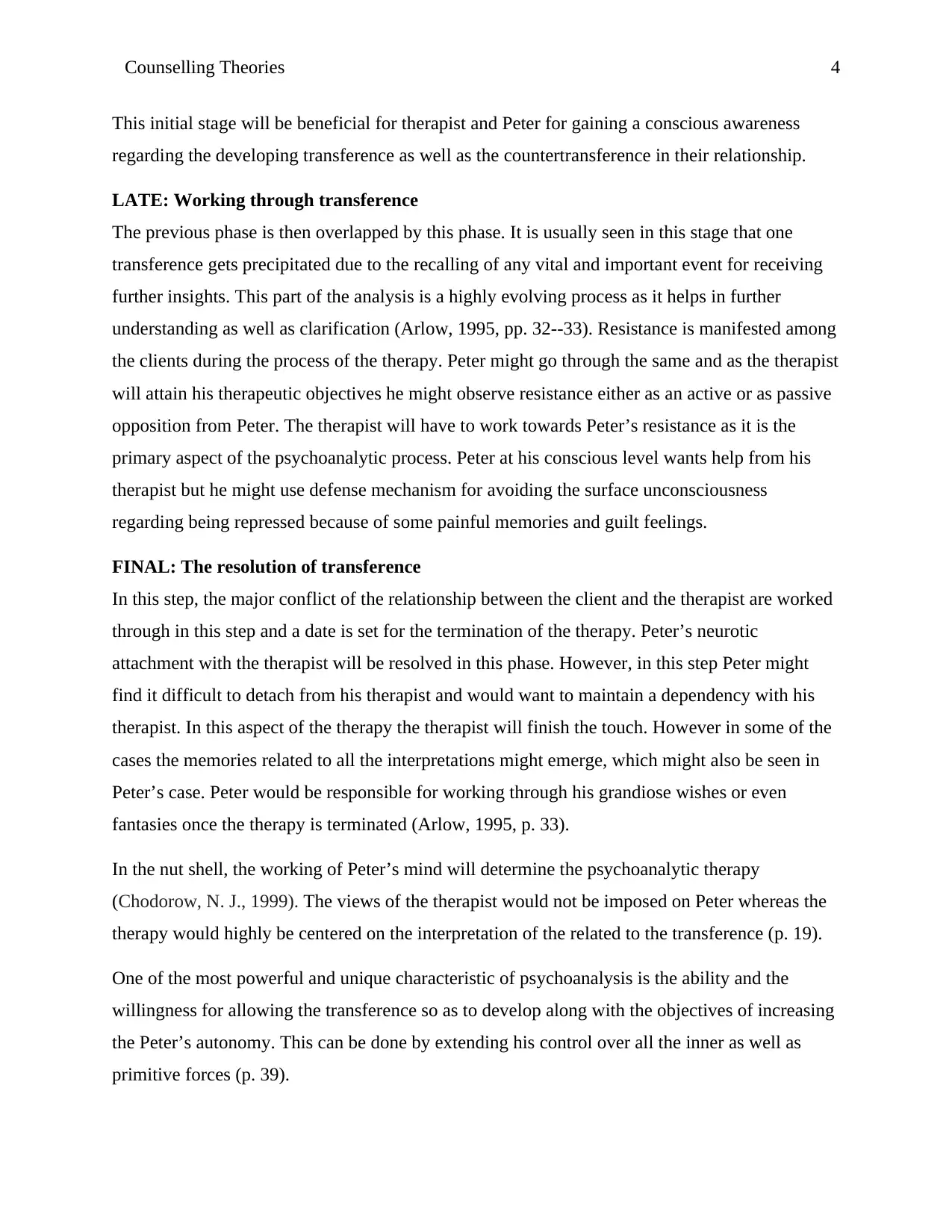
Counselling Theories 4
This initial stage will be beneficial for therapist and Peter for gaining a conscious awareness
regarding the developing transference as well as the countertransference in their relationship.
LATE: Working through transference
The previous phase is then overlapped by this phase. It is usually seen in this stage that one
transference gets precipitated due to the recalling of any vital and important event for receiving
further insights. This part of the analysis is a highly evolving process as it helps in further
understanding as well as clarification (Arlow, 1995, pp. 32--33). Resistance is manifested among
the clients during the process of the therapy. Peter might go through the same and as the therapist
will attain his therapeutic objectives he might observe resistance either as an active or as passive
opposition from Peter. The therapist will have to work towards Peter’s resistance as it is the
primary aspect of the psychoanalytic process. Peter at his conscious level wants help from his
therapist but he might use defense mechanism for avoiding the surface unconsciousness
regarding being repressed because of some painful memories and guilt feelings.
FINAL: The resolution of transference
In this step, the major conflict of the relationship between the client and the therapist are worked
through in this step and a date is set for the termination of the therapy. Peter’s neurotic
attachment with the therapist will be resolved in this phase. However, in this step Peter might
find it difficult to detach from his therapist and would want to maintain a dependency with his
therapist. In this aspect of the therapy the therapist will finish the touch. However in some of the
cases the memories related to all the interpretations might emerge, which might also be seen in
Peter’s case. Peter would be responsible for working through his grandiose wishes or even
fantasies once the therapy is terminated (Arlow, 1995, p. 33).
In the nut shell, the working of Peter’s mind will determine the psychoanalytic therapy
(Chodorow, N. J., 1999). The views of the therapist would not be imposed on Peter whereas the
therapy would highly be centered on the interpretation of the related to the transference (p. 19).
One of the most powerful and unique characteristic of psychoanalysis is the ability and the
willingness for allowing the transference so as to develop along with the objectives of increasing
the Peter’s autonomy. This can be done by extending his control over all the inner as well as
primitive forces (p. 39).
This initial stage will be beneficial for therapist and Peter for gaining a conscious awareness
regarding the developing transference as well as the countertransference in their relationship.
LATE: Working through transference
The previous phase is then overlapped by this phase. It is usually seen in this stage that one
transference gets precipitated due to the recalling of any vital and important event for receiving
further insights. This part of the analysis is a highly evolving process as it helps in further
understanding as well as clarification (Arlow, 1995, pp. 32--33). Resistance is manifested among
the clients during the process of the therapy. Peter might go through the same and as the therapist
will attain his therapeutic objectives he might observe resistance either as an active or as passive
opposition from Peter. The therapist will have to work towards Peter’s resistance as it is the
primary aspect of the psychoanalytic process. Peter at his conscious level wants help from his
therapist but he might use defense mechanism for avoiding the surface unconsciousness
regarding being repressed because of some painful memories and guilt feelings.
FINAL: The resolution of transference
In this step, the major conflict of the relationship between the client and the therapist are worked
through in this step and a date is set for the termination of the therapy. Peter’s neurotic
attachment with the therapist will be resolved in this phase. However, in this step Peter might
find it difficult to detach from his therapist and would want to maintain a dependency with his
therapist. In this aspect of the therapy the therapist will finish the touch. However in some of the
cases the memories related to all the interpretations might emerge, which might also be seen in
Peter’s case. Peter would be responsible for working through his grandiose wishes or even
fantasies once the therapy is terminated (Arlow, 1995, p. 33).
In the nut shell, the working of Peter’s mind will determine the psychoanalytic therapy
(Chodorow, N. J., 1999). The views of the therapist would not be imposed on Peter whereas the
therapy would highly be centered on the interpretation of the related to the transference (p. 19).
One of the most powerful and unique characteristic of psychoanalysis is the ability and the
willingness for allowing the transference so as to develop along with the objectives of increasing
the Peter’s autonomy. This can be done by extending his control over all the inner as well as
primitive forces (p. 39).
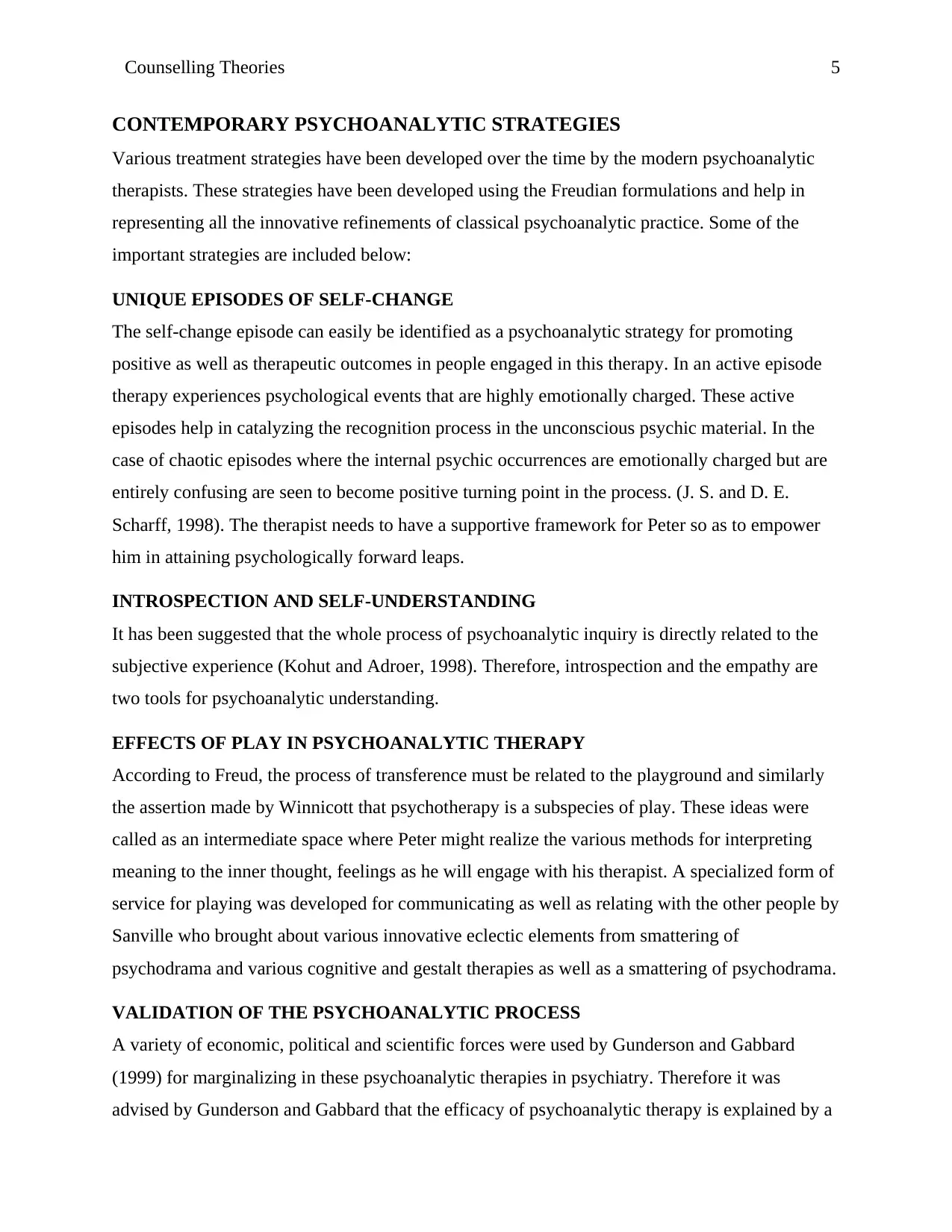
Counselling Theories 5
CONTEMPORARY PSYCHOANALYTIC STRATEGIES
Various treatment strategies have been developed over the time by the modern psychoanalytic
therapists. These strategies have been developed using the Freudian formulations and help in
representing all the innovative refinements of classical psychoanalytic practice. Some of the
important strategies are included below:
UNIQUE EPISODES OF SELF-CHANGE
The self-change episode can easily be identified as a psychoanalytic strategy for promoting
positive as well as therapeutic outcomes in people engaged in this therapy. In an active episode
therapy experiences psychological events that are highly emotionally charged. These active
episodes help in catalyzing the recognition process in the unconscious psychic material. In the
case of chaotic episodes where the internal psychic occurrences are emotionally charged but are
entirely confusing are seen to become positive turning point in the process. (J. S. and D. E.
Scharff, 1998). The therapist needs to have a supportive framework for Peter so as to empower
him in attaining psychologically forward leaps.
INTROSPECTION AND SELF-UNDERSTANDING
It has been suggested that the whole process of psychoanalytic inquiry is directly related to the
subjective experience (Kohut and Adroer, 1998). Therefore, introspection and the empathy are
two tools for psychoanalytic understanding.
EFFECTS OF PLAY IN PSYCHOANALYTIC THERAPY
According to Freud, the process of transference must be related to the playground and similarly
the assertion made by Winnicott that psychotherapy is a subspecies of play. These ideas were
called as an intermediate space where Peter might realize the various methods for interpreting
meaning to the inner thought, feelings as he will engage with his therapist. A specialized form of
service for playing was developed for communicating as well as relating with the other people by
Sanville who brought about various innovative eclectic elements from smattering of
psychodrama and various cognitive and gestalt therapies as well as a smattering of psychodrama.
VALIDATION OF THE PSYCHOANALYTIC PROCESS
A variety of economic, political and scientific forces were used by Gunderson and Gabbard
(1999) for marginalizing in these psychoanalytic therapies in psychiatry. Therefore it was
advised by Gunderson and Gabbard that the efficacy of psychoanalytic therapy is explained by a
CONTEMPORARY PSYCHOANALYTIC STRATEGIES
Various treatment strategies have been developed over the time by the modern psychoanalytic
therapists. These strategies have been developed using the Freudian formulations and help in
representing all the innovative refinements of classical psychoanalytic practice. Some of the
important strategies are included below:
UNIQUE EPISODES OF SELF-CHANGE
The self-change episode can easily be identified as a psychoanalytic strategy for promoting
positive as well as therapeutic outcomes in people engaged in this therapy. In an active episode
therapy experiences psychological events that are highly emotionally charged. These active
episodes help in catalyzing the recognition process in the unconscious psychic material. In the
case of chaotic episodes where the internal psychic occurrences are emotionally charged but are
entirely confusing are seen to become positive turning point in the process. (J. S. and D. E.
Scharff, 1998). The therapist needs to have a supportive framework for Peter so as to empower
him in attaining psychologically forward leaps.
INTROSPECTION AND SELF-UNDERSTANDING
It has been suggested that the whole process of psychoanalytic inquiry is directly related to the
subjective experience (Kohut and Adroer, 1998). Therefore, introspection and the empathy are
two tools for psychoanalytic understanding.
EFFECTS OF PLAY IN PSYCHOANALYTIC THERAPY
According to Freud, the process of transference must be related to the playground and similarly
the assertion made by Winnicott that psychotherapy is a subspecies of play. These ideas were
called as an intermediate space where Peter might realize the various methods for interpreting
meaning to the inner thought, feelings as he will engage with his therapist. A specialized form of
service for playing was developed for communicating as well as relating with the other people by
Sanville who brought about various innovative eclectic elements from smattering of
psychodrama and various cognitive and gestalt therapies as well as a smattering of psychodrama.
VALIDATION OF THE PSYCHOANALYTIC PROCESS
A variety of economic, political and scientific forces were used by Gunderson and Gabbard
(1999) for marginalizing in these psychoanalytic therapies in psychiatry. Therefore it was
advised by Gunderson and Gabbard that the efficacy of psychoanalytic therapy is explained by a
⊘ This is a preview!⊘
Do you want full access?
Subscribe today to unlock all pages.

Trusted by 1+ million students worldwide
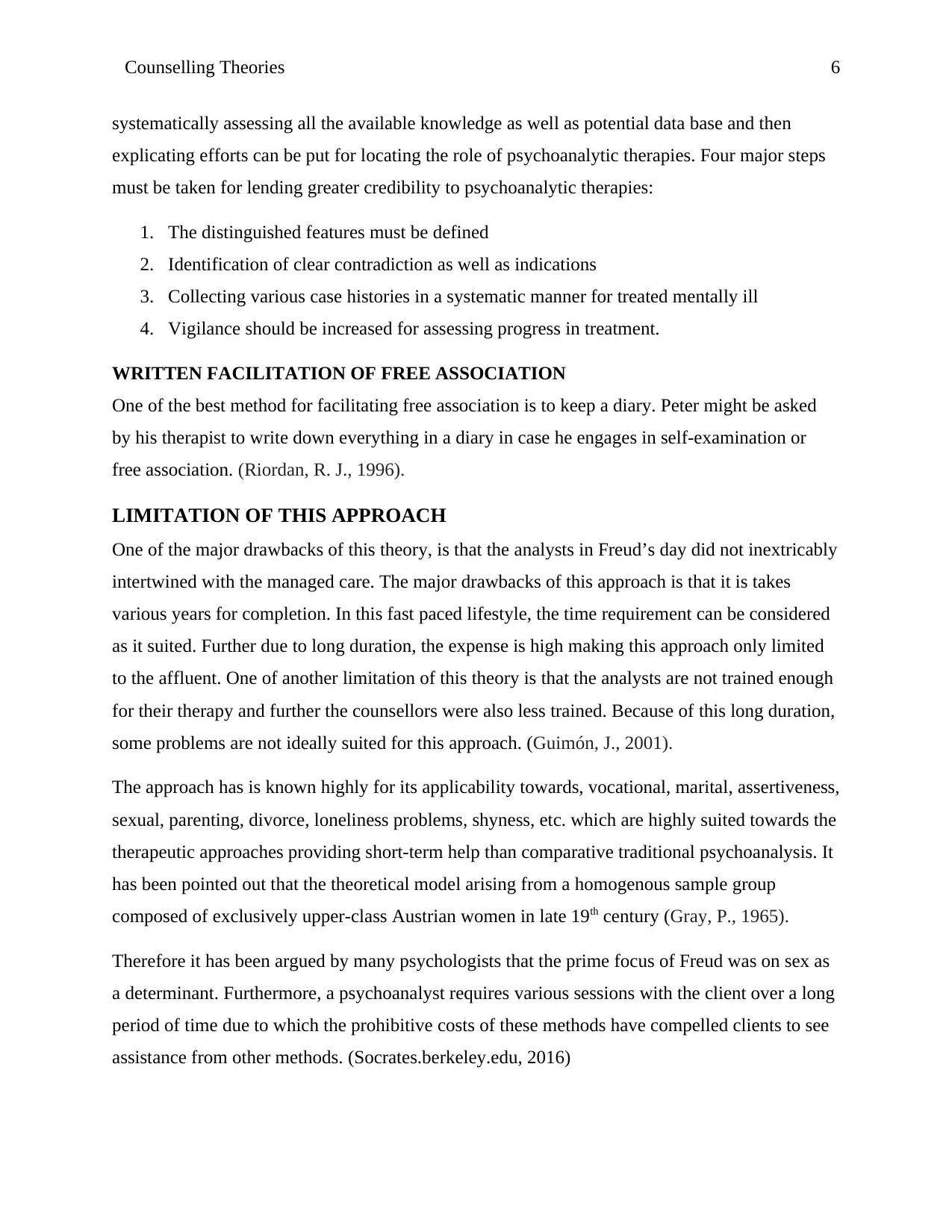
Counselling Theories 6
systematically assessing all the available knowledge as well as potential data base and then
explicating efforts can be put for locating the role of psychoanalytic therapies. Four major steps
must be taken for lending greater credibility to psychoanalytic therapies:
1. The distinguished features must be defined
2. Identification of clear contradiction as well as indications
3. Collecting various case histories in a systematic manner for treated mentally ill
4. Vigilance should be increased for assessing progress in treatment.
WRITTEN FACILITATION OF FREE ASSOCIATION
One of the best method for facilitating free association is to keep a diary. Peter might be asked
by his therapist to write down everything in a diary in case he engages in self-examination or
free association. (Riordan, R. J., 1996).
LIMITATION OF THIS APPROACH
One of the major drawbacks of this theory, is that the analysts in Freud’s day did not inextricably
intertwined with the managed care. The major drawbacks of this approach is that it is takes
various years for completion. In this fast paced lifestyle, the time requirement can be considered
as it suited. Further due to long duration, the expense is high making this approach only limited
to the affluent. One of another limitation of this theory is that the analysts are not trained enough
for their therapy and further the counsellors were also less trained. Because of this long duration,
some problems are not ideally suited for this approach. (Guimón, J., 2001).
The approach has is known highly for its applicability towards, vocational, marital, assertiveness,
sexual, parenting, divorce, loneliness problems, shyness, etc. which are highly suited towards the
therapeutic approaches providing short-term help than comparative traditional psychoanalysis. It
has been pointed out that the theoretical model arising from a homogenous sample group
composed of exclusively upper-class Austrian women in late 19th century (Gray, P., 1965).
Therefore it has been argued by many psychologists that the prime focus of Freud was on sex as
a determinant. Furthermore, a psychoanalyst requires various sessions with the client over a long
period of time due to which the prohibitive costs of these methods have compelled clients to see
assistance from other methods. (Socrates.berkeley.edu, 2016)
systematically assessing all the available knowledge as well as potential data base and then
explicating efforts can be put for locating the role of psychoanalytic therapies. Four major steps
must be taken for lending greater credibility to psychoanalytic therapies:
1. The distinguished features must be defined
2. Identification of clear contradiction as well as indications
3. Collecting various case histories in a systematic manner for treated mentally ill
4. Vigilance should be increased for assessing progress in treatment.
WRITTEN FACILITATION OF FREE ASSOCIATION
One of the best method for facilitating free association is to keep a diary. Peter might be asked
by his therapist to write down everything in a diary in case he engages in self-examination or
free association. (Riordan, R. J., 1996).
LIMITATION OF THIS APPROACH
One of the major drawbacks of this theory, is that the analysts in Freud’s day did not inextricably
intertwined with the managed care. The major drawbacks of this approach is that it is takes
various years for completion. In this fast paced lifestyle, the time requirement can be considered
as it suited. Further due to long duration, the expense is high making this approach only limited
to the affluent. One of another limitation of this theory is that the analysts are not trained enough
for their therapy and further the counsellors were also less trained. Because of this long duration,
some problems are not ideally suited for this approach. (Guimón, J., 2001).
The approach has is known highly for its applicability towards, vocational, marital, assertiveness,
sexual, parenting, divorce, loneliness problems, shyness, etc. which are highly suited towards the
therapeutic approaches providing short-term help than comparative traditional psychoanalysis. It
has been pointed out that the theoretical model arising from a homogenous sample group
composed of exclusively upper-class Austrian women in late 19th century (Gray, P., 1965).
Therefore it has been argued by many psychologists that the prime focus of Freud was on sex as
a determinant. Furthermore, a psychoanalyst requires various sessions with the client over a long
period of time due to which the prohibitive costs of these methods have compelled clients to see
assistance from other methods. (Socrates.berkeley.edu, 2016)
Paraphrase This Document
Need a fresh take? Get an instant paraphrase of this document with our AI Paraphraser
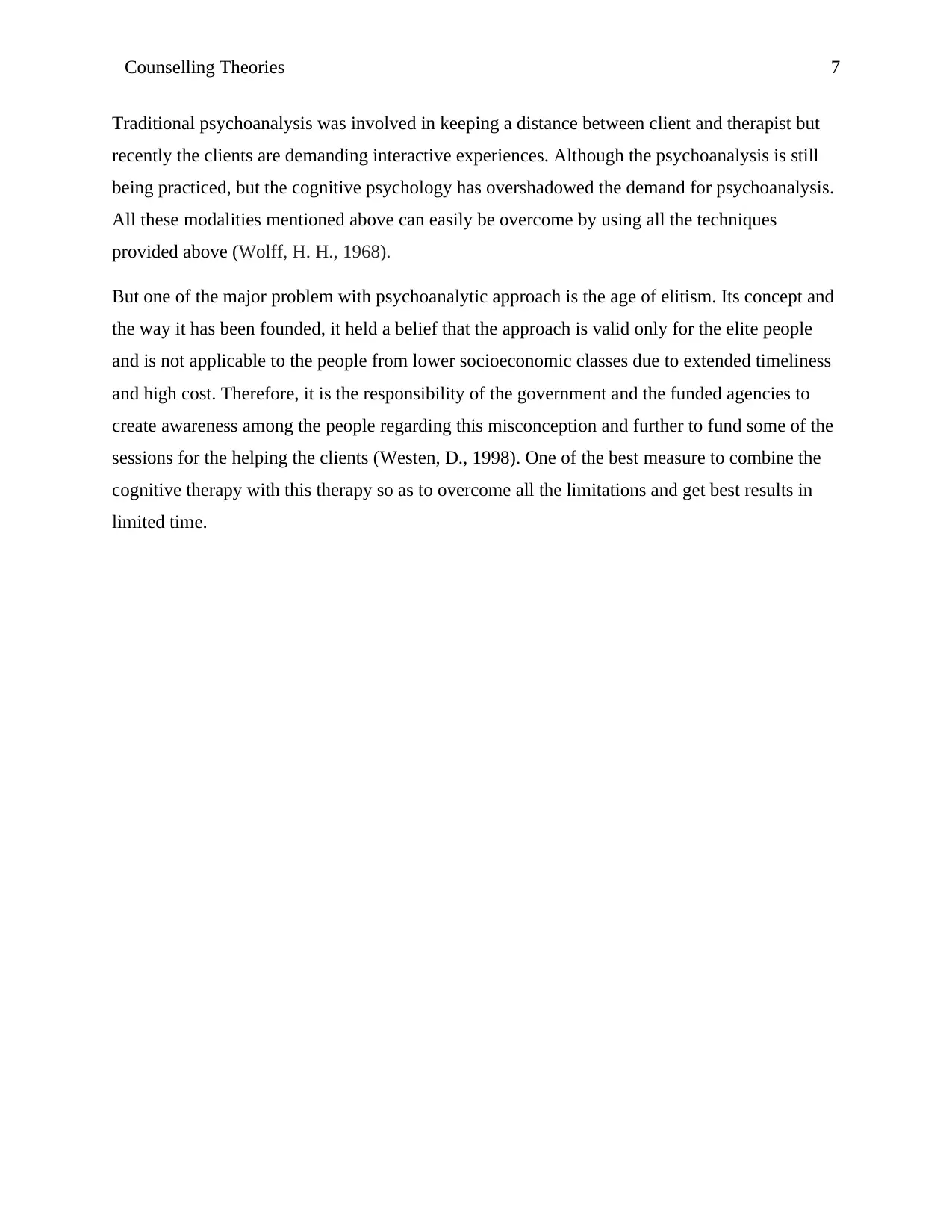
Counselling Theories 7
Traditional psychoanalysis was involved in keeping a distance between client and therapist but
recently the clients are demanding interactive experiences. Although the psychoanalysis is still
being practiced, but the cognitive psychology has overshadowed the demand for psychoanalysis.
All these modalities mentioned above can easily be overcome by using all the techniques
provided above (Wolff, H. H., 1968).
But one of the major problem with psychoanalytic approach is the age of elitism. Its concept and
the way it has been founded, it held a belief that the approach is valid only for the elite people
and is not applicable to the people from lower socioeconomic classes due to extended timeliness
and high cost. Therefore, it is the responsibility of the government and the funded agencies to
create awareness among the people regarding this misconception and further to fund some of the
sessions for the helping the clients (Westen, D., 1998). One of the best measure to combine the
cognitive therapy with this therapy so as to overcome all the limitations and get best results in
limited time.
Traditional psychoanalysis was involved in keeping a distance between client and therapist but
recently the clients are demanding interactive experiences. Although the psychoanalysis is still
being practiced, but the cognitive psychology has overshadowed the demand for psychoanalysis.
All these modalities mentioned above can easily be overcome by using all the techniques
provided above (Wolff, H. H., 1968).
But one of the major problem with psychoanalytic approach is the age of elitism. Its concept and
the way it has been founded, it held a belief that the approach is valid only for the elite people
and is not applicable to the people from lower socioeconomic classes due to extended timeliness
and high cost. Therefore, it is the responsibility of the government and the funded agencies to
create awareness among the people regarding this misconception and further to fund some of the
sessions for the helping the clients (Westen, D., 1998). One of the best measure to combine the
cognitive therapy with this therapy so as to overcome all the limitations and get best results in
limited time.
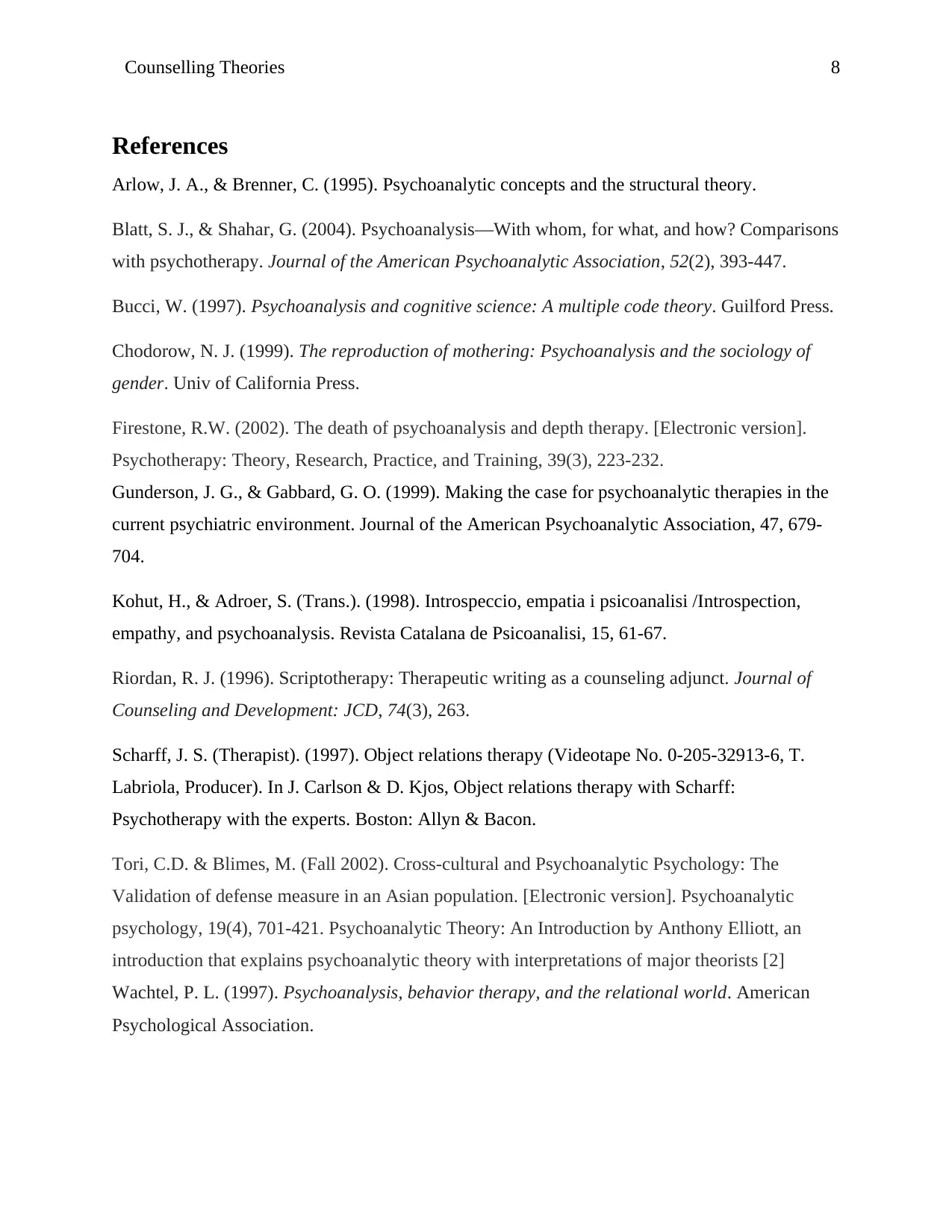
Counselling Theories 8
References
Arlow, J. A., & Brenner, C. (1995). Psychoanalytic concepts and the structural theory.
Blatt, S. J., & Shahar, G. (2004). Psychoanalysis—With whom, for what, and how? Comparisons
with psychotherapy. Journal of the American Psychoanalytic Association, 52(2), 393-447.
Bucci, W. (1997). Psychoanalysis and cognitive science: A multiple code theory. Guilford Press.
Chodorow, N. J. (1999). The reproduction of mothering: Psychoanalysis and the sociology of
gender. Univ of California Press.
Firestone, R.W. (2002). The death of psychoanalysis and depth therapy. [Electronic version].
Psychotherapy: Theory, Research, Practice, and Training, 39(3), 223-232.
Gunderson, J. G., & Gabbard, G. O. (1999). Making the case for psychoanalytic therapies in the
current psychiatric environment. Journal of the American Psychoanalytic Association, 47, 679-
704.
Kohut, H., & Adroer, S. (Trans.). (1998). Introspeccio, empatia i psicoanalisi /Introspection,
empathy, and psychoanalysis. Revista Catalana de Psicoanalisi, 15, 61-67.
Riordan, R. J. (1996). Scriptotherapy: Therapeutic writing as a counseling adjunct. Journal of
Counseling and Development: JCD, 74(3), 263.
Scharff, J. S. (Therapist). (1997). Object relations therapy (Videotape No. 0-205-32913-6, T.
Labriola, Producer). In J. Carlson & D. Kjos, Object relations therapy with Scharff:
Psychotherapy with the experts. Boston: Allyn & Bacon.
Tori, C.D. & Blimes, M. (Fall 2002). Cross-cultural and Psychoanalytic Psychology: The
Validation of defense measure in an Asian population. [Electronic version]. Psychoanalytic
psychology, 19(4), 701-421. Psychoanalytic Theory: An Introduction by Anthony Elliott, an
introduction that explains psychoanalytic theory with interpretations of major theorists [2]
Wachtel, P. L. (1997). Psychoanalysis, behavior therapy, and the relational world. American
Psychological Association.
References
Arlow, J. A., & Brenner, C. (1995). Psychoanalytic concepts and the structural theory.
Blatt, S. J., & Shahar, G. (2004). Psychoanalysis—With whom, for what, and how? Comparisons
with psychotherapy. Journal of the American Psychoanalytic Association, 52(2), 393-447.
Bucci, W. (1997). Psychoanalysis and cognitive science: A multiple code theory. Guilford Press.
Chodorow, N. J. (1999). The reproduction of mothering: Psychoanalysis and the sociology of
gender. Univ of California Press.
Firestone, R.W. (2002). The death of psychoanalysis and depth therapy. [Electronic version].
Psychotherapy: Theory, Research, Practice, and Training, 39(3), 223-232.
Gunderson, J. G., & Gabbard, G. O. (1999). Making the case for psychoanalytic therapies in the
current psychiatric environment. Journal of the American Psychoanalytic Association, 47, 679-
704.
Kohut, H., & Adroer, S. (Trans.). (1998). Introspeccio, empatia i psicoanalisi /Introspection,
empathy, and psychoanalysis. Revista Catalana de Psicoanalisi, 15, 61-67.
Riordan, R. J. (1996). Scriptotherapy: Therapeutic writing as a counseling adjunct. Journal of
Counseling and Development: JCD, 74(3), 263.
Scharff, J. S. (Therapist). (1997). Object relations therapy (Videotape No. 0-205-32913-6, T.
Labriola, Producer). In J. Carlson & D. Kjos, Object relations therapy with Scharff:
Psychotherapy with the experts. Boston: Allyn & Bacon.
Tori, C.D. & Blimes, M. (Fall 2002). Cross-cultural and Psychoanalytic Psychology: The
Validation of defense measure in an Asian population. [Electronic version]. Psychoanalytic
psychology, 19(4), 701-421. Psychoanalytic Theory: An Introduction by Anthony Elliott, an
introduction that explains psychoanalytic theory with interpretations of major theorists [2]
Wachtel, P. L. (1997). Psychoanalysis, behavior therapy, and the relational world. American
Psychological Association.
⊘ This is a preview!⊘
Do you want full access?
Subscribe today to unlock all pages.

Trusted by 1+ million students worldwide
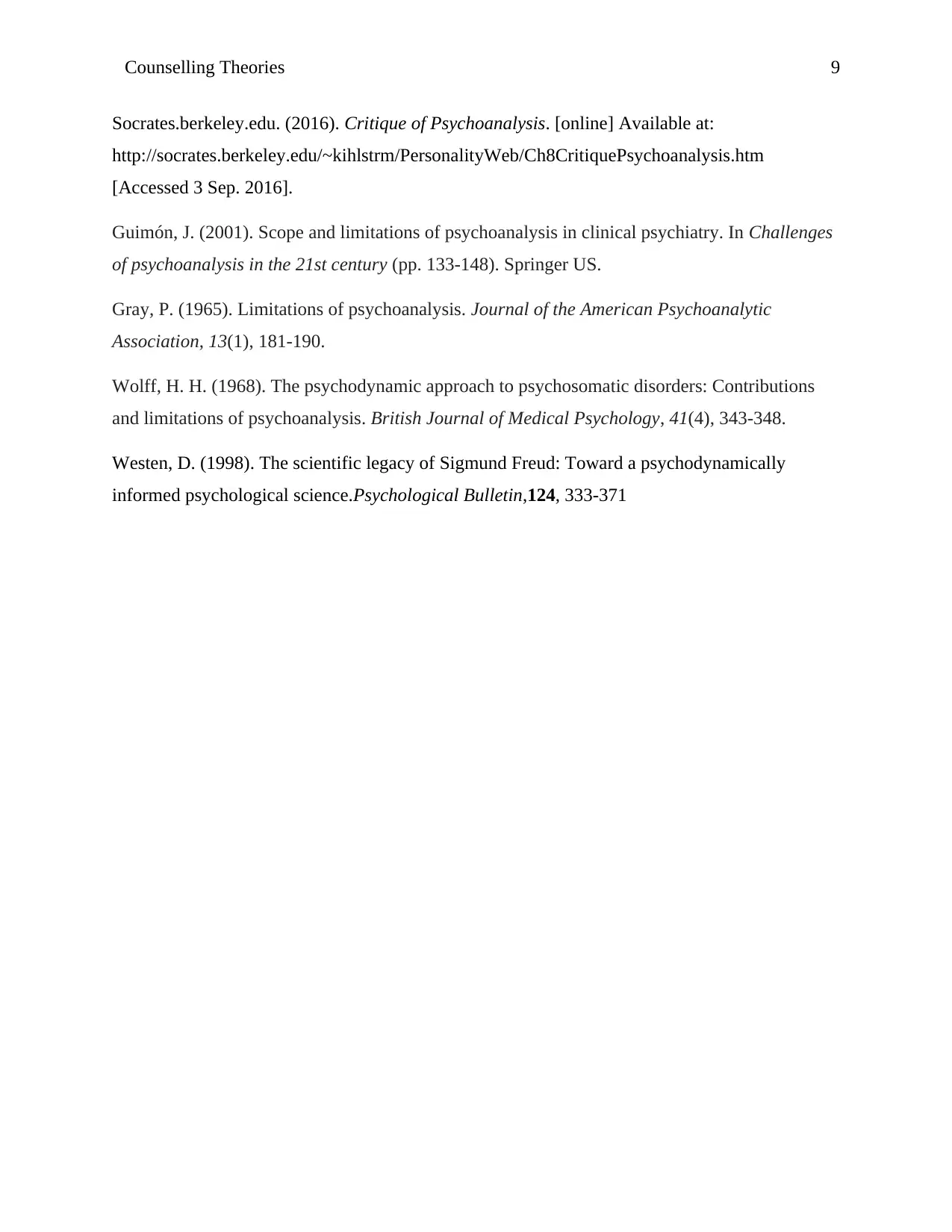
Counselling Theories 9
Socrates.berkeley.edu. (2016). Critique of Psychoanalysis. [online] Available at:
http://socrates.berkeley.edu/~kihlstrm/PersonalityWeb/Ch8CritiquePsychoanalysis.htm
[Accessed 3 Sep. 2016].
Guimón, J. (2001). Scope and limitations of psychoanalysis in clinical psychiatry. In Challenges
of psychoanalysis in the 21st century (pp. 133-148). Springer US.
Gray, P. (1965). Limitations of psychoanalysis. Journal of the American Psychoanalytic
Association, 13(1), 181-190.
Wolff, H. H. (1968). The psychodynamic approach to psychosomatic disorders: Contributions
and limitations of psychoanalysis. British Journal of Medical Psychology, 41(4), 343-348.
Westen, D. (1998). The scientific legacy of Sigmund Freud: Toward a psychodynamically
informed psychological science.Psychological Bulletin,124, 333-371
Socrates.berkeley.edu. (2016). Critique of Psychoanalysis. [online] Available at:
http://socrates.berkeley.edu/~kihlstrm/PersonalityWeb/Ch8CritiquePsychoanalysis.htm
[Accessed 3 Sep. 2016].
Guimón, J. (2001). Scope and limitations of psychoanalysis in clinical psychiatry. In Challenges
of psychoanalysis in the 21st century (pp. 133-148). Springer US.
Gray, P. (1965). Limitations of psychoanalysis. Journal of the American Psychoanalytic
Association, 13(1), 181-190.
Wolff, H. H. (1968). The psychodynamic approach to psychosomatic disorders: Contributions
and limitations of psychoanalysis. British Journal of Medical Psychology, 41(4), 343-348.
Westen, D. (1998). The scientific legacy of Sigmund Freud: Toward a psychodynamically
informed psychological science.Psychological Bulletin,124, 333-371
1 out of 10
Related Documents
Your All-in-One AI-Powered Toolkit for Academic Success.
+13062052269
info@desklib.com
Available 24*7 on WhatsApp / Email
![[object Object]](/_next/static/media/star-bottom.7253800d.svg)
Unlock your academic potential
Copyright © 2020–2025 A2Z Services. All Rights Reserved. Developed and managed by ZUCOL.





